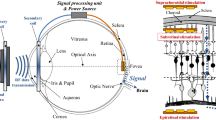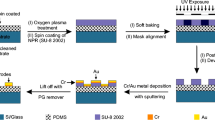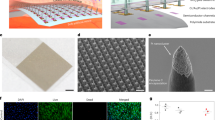Abstract
In order to provide high-quality visual information to patients with implanted retinal prosthetic devices, the number of microelectrode should be large. As the number of microelectrodes is increased, the dimensions of the microelectrode are also decreased, which in turn results in increased interface impedance of the microelectrodes and decreased dynamic range of injection current. In addition, the reduced maximum limit of injection current may not be sufficiently large to stimulate the ganglion cells in the retina. In order to improve the trade-off between the number of microelectrodes and the current injection limit, a 3D microelectrode structure can be used as an alternative. Due to the advancement of microfabrication technology, the fabrication of highly-accurate 3D structures with small dimensions is possible. This paper presents a comprehensive electrical characterization of 2D and 3D microelectrodes. Microelectrodes that differ in shape and diameter are compared to evaluate the feasibility of use in high-resolution retinal prostheses. Their electrode–electrolyte interface impedances and charge injection limits are quantitatively analyzed. Also, in vitro animal experiments using rd1 mice are performed to observe the evoked neural responses by increasing the stimulation current amplitude from 10 to 100 μA. This research can be used to define requirements for further retinal prosthetic device research.









Similar content being viewed by others
References
Ahn J, Lee S, Hong S, Yoo H, Jung S, Park S, Ko H, Cho D (2013) Multi-channel stimulator IC using a channel sharing method for retinal prostheses. J Biomed Nanotechnol 9:621–625
Chen K, Yang Z, Hoang L, Weiland JD, Humayun MS, Liu W (2010) An integrated 256-channel epiretinal prosthesis. IEEE J Solid-State Circuits 45(9):1945–1956
Choi D-K (2016) Mechanical characterization of biological tissues: experimental methods based on mathematical modeling. Biomed Eng Lett 6(3):181–195
Congdon N, O’Colmain B, Klaver CC, Klein R, Munoz B, Friedman DS, Kempen J, Taylor HR, Mitchell P (2004) Causes and prevalence of visual impairment among adults in the United States. Arch Ophthalmol 122:477–485
Emerich D, Thanos C (2008) NT-501: an ophthalmic implant of polymer-encapsulated ciliary neurotrophic factor-producing cells. Curr Opin Mol Ther 10(5):506
Goo YS, Ye JH, Lee S, Nam Y, Ryu SB, Kim KH (2011) Retinal ganglion cell responses to voltage and current stimulation in wild-type and rd1 mouse retinas. J Neural Eng 8:035003
Gwon TM, Kim C, Shin S, Park JH, Kim SJ (2016) Liquid crystal polymer (LCP)-based neural prosthetic devices. Biomed Eng Lett 6(3):148–163
Im C, Seo J-M (2016) A review of electrodes for the electrical brain signal recording. Biomed Eng Lett 6(3):104–112
Jones BW, Marc RE (2005) Retinal remodeling during retinal degeneration. Exp Eye Res 81:123–137
Kusko M, Craciunoiu F, Amuzescu B, Halitzchi F, Selescu T, Radoi A, Popescu M, Simion M, Bragaru A, Ignat T (2012) Design, fabrication and characterization of a low-impedance 3D Electrode array system for neuro-electrophysiology. Sensors 12:16571–16590
Lee S, Ahn J, Seo J-M, Chung H, Cho D (2015) Electrical characterization of 3D Au microelectrodes for use in retinal prostheses. Sensors 15:14345–14355
Lee W, Shim S, Park JH, Kim SJ (2016) A three-dimensional neural cell construct for implantable neural interface. Biomed Eng Lett 6(3):172–180
Liu MM, Tuo J, Chan CC (2011) Gene therapy for ocular diseases. Br J Ophthalmol 95(5):604–612
Meyer JU (2002) Retina implant—a bioMEMS challenge. Sens Actuators A phys 97:1–9
Pérez Fornos A, Sommerhalder J, Pittard A, Safran AB, Pelizzone M (2008) Simulation of artificial vision: IV. Visual information required to achieve simple pointing and manipulation tasks. Vision Res 48(16):1705–1718
Lee S, Ahn J, Yoo H, Jung S, Oh S, Park S, Cho D (2013) “Electrical characteristics of 2D and 3D microelectrodes for high-resolution retinal prostheses. In Proceedings of the 35th Annual International Conference of the IEEE Engineering in Medicine and Biology Society, Osaka, Japan, 3–7 July
Santos A, Humayun MS, de Juan Jr E, Greenburg RJ, Marsh MJ, Klock IB, Milam AH (1997) Preservation of the inner retina in retinitis pigmentosa: a morphometric analysis. Arch Ophthalmol 115(4):511
Shah S, Hines A, Zhou D, Greenberg RJ, Humayun MS, Weiland JD (2007) Electrical properties of retinal–electrode interface. J Neural Eng 4(1):S24
Stone JL, Barlow WE, Humayun MS, de Juan Jr E, Milam AH (1992) Morphometric analysis of macular photoreceptors and ganglion cells in retinas with retinitis pigmentosa. Arch Ophthalmol 110(11):1634
Zrenner E, Bartz-Schmidt KU, Benav H, Besch D, Bruckmann A, Gabel VP, Gekeler F, Greppmaier U, Harscher A, Kibbel S (2011) Subretinal electronic chips allow blind patients to read letters and combine them to words. Proceeding of the Royal Society B: Biological Sciences 278(1711):1489–1497
Acknowledgements
This work was supported by the Center for Integrated Smart Sensors funded by the Ministry of Science, ICT & Future Planning as "Global Frontier Project” (CISS- 2011-0031863).
Author information
Authors and Affiliations
Corresponding author
Rights and permissions
About this article
Cite this article
Ko, H., Lee, S. Electrical characterization of 2D and 3D microelectrodes for achieving high-resolution sensing in retinal prostheses with in vitro animal experimental results. Microsyst Technol 23, 473–481 (2017). https://doi.org/10.1007/s00542-017-3287-y
Received:
Accepted:
Published:
Issue Date:
DOI: https://doi.org/10.1007/s00542-017-3287-y




